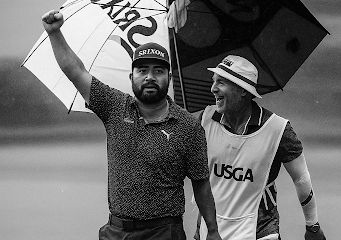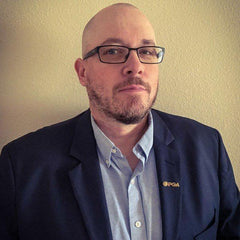The mathematics of J.J. Spaun's U.S. Open victory simply don't add up. A player who had never made a U.S. Open cut, standing 120-1 odds, doesn't typically find himself addressing a tournament-winning putt at one of golf's most demanding venues.
Yet there was Spaun on Oakmont's unforgiving 18th green, his putter in hand and history within reach. The 34-year-old Californian had already rewritten his own story once that Sunday, transforming a five-bogey nightmare stretch into championship contention. Now, with 65 feet of Pennsylvania steel between him and immortality, the only question was whether one more impossible thing could happen.

The answer came in the form of 64 feet and 5 inches of pure precision—a putt that defied Oakmont's reputation for humbling even the game's greatest players. When the ball found the bottom of the cup, it completed a journey that began not with destiny, but with doubt, and ended with the kind of sporting miracle that reminds us why we watch.
The Psychology of Resurrection
Championships aren't won in the first six holes, but they can certainly be lost there. Spaun's early Sunday meltdown—five bogeys that had him staring at a 5-over front nine—would have broken most players' spirits. In major championship golf, such collapses typically signal the end of the conversation, not the beginning of a comeback story.
What makes Spaun's turnaround extraordinary isn't just the 3-under back nine that followed, but the mental architecture required to rebuild a championship mindset in real time. While veteran contenders like Sam Burns and Adam Scott succumbed to Oakmont's pressure, Spaun discovered something more valuable than perfect ball-striking: the ability to separate each shot from the catastrophe of the previous one.
The rain delay became his reset button. In those 97 minutes of waiting, Spaun's team helped him reframe the narrative. This wasn't about recovering from disaster, it was about seizing an opportunity that 95% of professional golfers never get. The shift in perspective proved as crucial as any technical adjustment.
When play resumed, Spaun attacked Oakmont with the freedom of someone who had already lost everything, which paradoxically gave him everything he needed to win. J.J. Spaun's victory was a masterclass in course management that should be studied by golfers everywhere.
The Moment of Truth
Everything hinged on 314 yards of Pennsylvania turf. Standing on the 17th tee, one shot behind with two holes remaining, Spaun confronted the kind of decision that separates major champions from also-rans. The par-4 17th at Oakmont offers a tantalizing risk-reward proposition: driver to the green for eagle or birdie, or the safer play that leaves a simple wedge shot, but no guarantee.
For a player who had spent the morning battling disaster, the conservative choice might have seemed prudent. Instead, Spaun chose audacity. His driver cut through the air with the precision of a surgeon's scalpel, landing softly on the putting surface and rolling to rest 18 feet from glory.
Two putts later, Spaun owned the outright lead for the first time since Thursday morning. The drivable par-4 had become his launching pad to immortality, transforming what had been a day of survival into one of conquest.
The Agony of Almost
In the scorer's tent, Robert MacIntyre could only watch as his dreams played out on television screens. The 28-year-old Scotsman had authored his own masterpiece of resilience with weekend rounds of 69-68 that made him the lone player to conquer Oakmont on both Saturday and Sunday. His 1-over total represented everything that makes golf simultaneously beautiful and cruel: perfect execution that falls just short of perfect timing.
MacIntyre's journey to the runner-up position had been a testament to the Scottish spirit that forged him. After early-week struggles, he had clawed his way back with the kind of determined play that would have won most major championships. But this was Oakmont, where second place often feels like both triumph and tragedy.
As Spaun's final putt found its target, MacIntyre's graciousness in defeat spoke to a character that will surely bring him back to major championship contention. The $2.322 million prize provided financial consolation, but for a player who came within two shots of Scottish golf immortality, the what-ifs will linger longest.
Putting Prowess Under Pressure

While J.J. Spaun's ball-striking carried him through most of the week, his putting performance proved to be the decisive factor in securing victory. At the U.S. Open, Spaun demonstrated remarkable putting prowess when it mattered most, ranking 2nd in Strokes Gained: Putting with an impressive +2.591 average per round.
Most spectacularly, Spaun led the entire field in putting inside 10 feet, converting an exceptional 93.75% of his attempts (60 made from 64 attempts). This clutch performance on makeable putts proved invaluable on Oakmont's treacherous greens, where even short putts carried significant risk.
Spaun's three-putt avoidance was equally impressive, making only 2 three-putts in 72 holes (2.78%), tying for 10th in the field. This steady approach proved crucial on greens where the tour average for three-putts was 6.71% for the week. His 30.75 putts per round tied for 20th place, demonstrating the efficiency that separated him from the field.
In contrast, runner-up Robert MacIntyre showed his own putting excellence, ranking 4th in Strokes Gained: Putting at +1.630 strokes per round. MacIntyre's 30.75 putts per round matched Spaun's efficiency, and both players demonstrated the putting consistency required to contend at Oakmont. The fact that both finalists averaged the same number of putts per round highlighted how Spaun's superior performance inside 10 feet made the crucial difference.
The putting statistics revealed the mental fortitude required to win at Oakmont. Spaun's dominant performance on short putts—leading the field at 93.75%—showed his ability to capitalize when opportunities arose, ultimately separating him from a field where every stroke mattered.
Historic Achievement
In an era where golf's elite increasingly dominate major championships, Spaun's victory serves as a reminder that the sport's greatest theater still belongs to the unexpected. His triumph wasn't just about putting prowess or mental fortitude, it was also about the collision between preparation and possibility that defines all great sporting achievements.
The $4.3 million winner's check will change Spaun's bank account, but the lasting impact extends far beyond financial security. He has proven that in golf's most demanding arena, the only prerequisite for greatness is the willingness to believe it's possible, even when everything suggests otherwise.
Years from now, when golf historians recount the 125th U.S. Open, they'll remember Oakmont's unforgiving nature and the field it humbled. But they'll also remember the 64-foot putt that transformed a journeyman into a champion, proving that sometimes the longest shots are the ones most worth taking.





